High-speed Camera Technical Data
SpeedCam
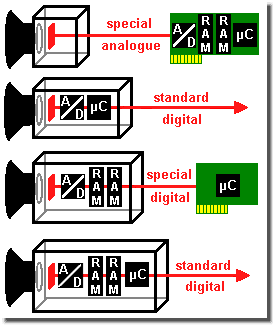
Digital high-speed camera concepts
Existing analog high-speed film cameras still have
their rights in the field of high frame rates of several
10 000 frames/sec. Even if the state of the art digital video
systems have already broken through the 1 000 000
frames/sec barrier. The resolution in this region, however, is very
strictly limited then. Nevertheless, already there are sensors with
about 1 000 x 1 000 pixel at 5 000 frames/sec Full
HD 1080p or with more than 2 500 frames/sec and more than
500 000 frames/sec or even more than 1 million frames/sec at
reduced resolution are possible. As a rule of thumb one can say
that at maximum frequency the resolution at least decreases
proportional to that at standard frequency - 10 times faster with
at at least 10 times reduced resolution.
But digitization rules! The roots of digital high-speed camera
systems go back to the early 1980s or even before them. Their
resolutions, however, were rather low - some ten by ten pixels at
some hundred frames per second.
Legend to the figure on the right: RAM = image
memory; µC = microcontroller or processor; A/D = analog to
digital conversion (often already integrated in the sensor)
The green card should show a PC card, the red line connection
possibilities (image and control data).
The standard connection can be e.g. (Gigabit) Ethernet or
FireWire.
Overview
System description
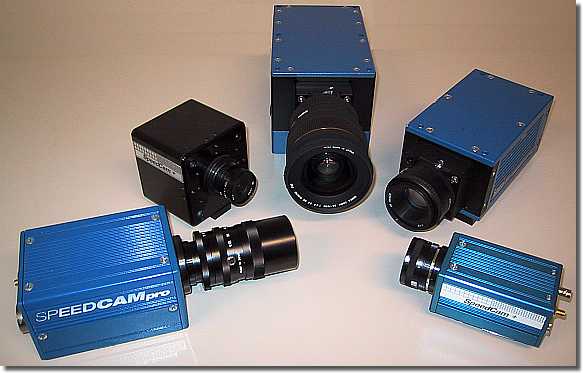
A selection of digital high-speed cameras, ancient company
Weinberger 1993 to 2008
Each SpeedCam appliance, here chosen as typical example
and due to being familiar to them, was a member of a family of fully
digital PC based electronic (video) high-speed camera systems of
the ancient company Weinberger (closed in September 2008, but
servicing until 2016). They were designed as turnkey systems
like most high-speed cameras. Consisting of a camera (head),
software and depending on type with control device/host PC. Here
just a not complete comparison of different system generations as
some kind of gallery of forefathers in order to show what is
possible and how it has been done.
More info about other systems and manufacturers you can find also
in the [SloMo Links]
section of this site.
Comparing the systems one recognizes the development to
significant better resolutions with moderately increasing frame
rates. A »Triple-K-Camera« (1 000 x 1 000 pixels per
square at 1 000 frames/sec) meets the entry level demands of
today's high-end »mainstream« market. With resolutions in the
megapixel class the image quality of high-speed film cameras has been
reached making it possible to replace this technology in great
scale.
By the way: these digital high-speed cameras were often used by
professionals as digital normal speed video cameras (25 or 30
frames/sec and 50 or 60 frames/sec, resp.) for making movies/videos.
Their image quality was everything one could wish for and they were
possibly cheaper than usual video cameras for professional
broadcasting use. And all speeds were possible - 25, 30, 50 or 60
frames/sec, even 24 frames/sec as used for cinema movies.
Technical data
Each resolution is given by columns x lines. Specs without guarantee.
| SpeedCam +2000 | SpeedCam +500, SpeedCam lite | SpeedCam 512, SpeedCam PRO, LT, G plus | SpeedCam Visario g1, g2, g3 | ||||
|---|---|---|---|---|---|---|---|
| Dalsa CA-D1-0128A CCD | Dalsa CA-D1-0256A CCD | EG&G HS0512JAQ CCD | FhG/CSEM Cam 2000 Visario CMOS | ||||
| Image RAM: 64MB, 128MB, 256MB | Image RAM: 64MB, 128MB, 256MB | Image RAM: 64MB, 128MB, 256MB, 512MB, 1GB | Image RAM: 1GB, 2GB, 4GB, 8GB, ... 48GB (g3) | ||||
| Resolution |
Frame rates [in frames/sec] |
Resolution |
Frame rates [in frames/sec] |
Resolution |
Frame rates [in frames/sec] |
Resolution |
Frame rates [in frames/sec] |
| 128 x 128 | 200 - 2 020 | 256 x 256 | 50 - 531 | 512 x 512 | 50 - 1 094 | 1536 x 1024 | 10 - 1 106 |
| 128 x 64 | - 4 040 | 256 x 128 | - 1 020 | 256 x 512 | - 2 031 | 1 024 x 768 | - 2 000 |
| 128 x 32 | - 6 400 | 256 x 64 | - 1 800 | 128 x 512 | - 3 188 | 768 x 512 | - 4 000 |
| 128 x 16 | - 11 200 | 256 x 32 | - 3 400 | 64 x 512 | - 4 457 |
512 x 192 256 x 96 (g3) 256 x 16 (g3) |
- over 10 000 - 40 000 (g3) - over 100 000 (g3) |
| Displayed without dependence on resolution in 512 x 512 non interlaced format, i.e. constant field of view. | No binning. Aspect ratio depending on resolution. | ||||||
Technical data of the SpeedCam high-speed cameras
SpeedCam 500+/2000+ systems came to market in the early 1990s.
In the middle of the 1990s complemented by SpeedCam Lite and
SpeedCam 512.
With the SpeedCam PRO including LT (single channel variant) and G
plus (crash-proofed control host) starting in the end 1990s one
could choose between color and monochrome camera versions. Even the
mixed operation at the same host was possible.
With SpeedCam Visario (Generation 1) the new millennium was
inaugurated. The reference class in 2001/02. Now even cameras of
different memory capacity could operate in parallel. 2004/05
SpeedCam Visario g2 (Generation 2) continued the development to the
stand-alone and crash-proofed camera. In 2007 SpeedCam Visario g3
(Generation 3) again pushed the landmarks sensitivity, dynamic and
frame rate in a considerable manner.
Well, even in those days a great stuff was possible. (And they
continue to work more than Ten Years After ;-)
Correlation between frame rate, recording capacity and resolution

Relationship image and memory [SloMo Image RAM]
Each SpeedCam system uses the full resolution of its
sensor just slightly above nominal frame rate (see the table
above) to offer some reserve for re-synchronization during external
synchronization and especially during clock jitter. All resolution steps
show this behavior. Even with maximum frequency.
With increasing frame rates two, three and finally four lines or
columns, resp., of the CCD sensors are combined step by step and are
read out (binning). The field of view remains the same,
but the quality of the images decreases. With heavy reduction they
may show then some kind of beam structure or graded etches. The
table above shows the dependence of maximum resolution on maximum
frame rate.
Concerning the SpeedCam Visario CMOS sensor, however, the
resolution (i.e. quality) remains the same, but the field of view
changes, see the figure on the right and for details click
[SloMo Image RAM].
Of course, one cannot speak of quality in usual terms concerning
the harsh resolution reduction binning modes, but the spreading of
a crack or of a wave front can be visualized. As experience shows
halving the resolution does not cause a significant loss of quality.
Besides one can just rotate the camera head by 90° to get the high
resolution in the preference direction of the movement.
The required illumination does not increase due to the combining
of lines/columns when binning and remains nearly the same, so a
SpeedCam PRO system does not need more light for 3 000
frames/sec with a resolution of 128 x 512 pixels than for
1 000 frames/sec with 512 x 512 pixels.
With binning-less SpeedCam Visario time of exposure is just a
matter of shutter time or frame rate, resp. only.
The recording time depends on the resulting data amount. The
memory extension is the stable part, the rest is flexible more or
less. The following formula shows the general connection (with
8 bit = 1 byte; 1 kbyte = 1024 byte). It is valid for all digital
video cameras in general.
Memory extension [byte] =
= resolution [pixel] × color depth [byte/pixel] × frame rate
[frames/sec] × recording time [sec] =
= columns × lines × 1 × frame rate ×
recording time
To calculate with these high-speed camera systems listed in the
table above e.g. 1 Gbyte, the maximum memory extension of
SpeedCam PRO, is sufficient enough for 1 Gbyte / (512 x 512 x
1 byte x 1 000/sec) = 4 seconds. For 2 000
frames/sec it covers 4 seconds as well, because the column number
is halved.
SpeedCam Visario and other up to date cameras, however, operate at
a color depth per channel of 10 bit or 12 bit. Here the
color depth factor is then 10/8 = 1.2 [byte/pixel] or respectively
12/8 = 1.5 [byte/pixel].
Of course, one can voluntary reduce the frame rate and/or
resolution. A memory extension of 1 Gbyte lasts e.g. for 16
seconds with 250 frames/sec at 512 x 512 pixels or for 32 seconds
with the same frequency, but at 256 x 512 pixels.
By the way: as undocumented feature many of high-speed camera
systems offer more or less limited support of the so-called
wobbling (also named sweep). When one puts a moderate changing
frequency to the SYNC IN socket, it will be continuously taken as
present recording frequency. This may be interesting for shooting
ramp up sets like the start up of a motor.
System configuration
Two worlds side by side: PC plus camera
The configurations of SpeedCam +500/+2000 and SpeedCam 512
systems are are based on a 19 inch industrial PC with passive ISA
bus board as it was state of the art in the early 1990s when they
have been developed. Due to the separation of PC and camera section
possibly up to three channels per host are available, because the
camera section has its own communication channels. So e.g. to
support fast replay video data can be stored back from the harddisk
to the memory banks on the frame grabber. In general the system
configuration matches the figure below. Operating system is MS-DOS
on Intel 80486 processors.
SpeedCam lite is lacking of the host PC section and the
possibilities associated with it. But it is designed for (extreme)
field use - easy to handle and easy to carry and it even offers built
in rechargeable battery (accumulator ) and monitor.
Two worlds combined: camera system with PC
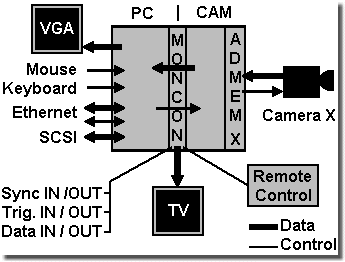
SpeedCam PRO data and control paths
For the control unit of the SpeedCam PRO (and LT, G plus) system
a switch to an industrial 19 inch rack with CompactPCI bus as it
has become common in the mid 1990s has taken place. For data- and
control paths and for peripherals to connect, too, see the figure
on the left. (Of course, PC standard ports like LPT, COM ...
are supported.)
Possibly up to four channels per host are available.
The generated data rate of up to 256 Mbyte/sec per channel
cannot be transferred to the computer section in real time, because
a PCI based bus offers a theoretic capacity of maximum
132 Mbyte/sec (33 MHz with 32 bit bandwidth) only.
Therefore the image data of each channel are spooled to DRAM
benches on the according ADMEM (= A/D conversion + memory) card and
later they are written through the MONCON (= monitor + control)
card to the harddisk of the host PC. All image data, even those
already stored on the harddisk, can be replayed any times on the
host PC and on the TV monitor or can be sent to a video recorder,
resp.
SpeedCam PRO systems can be remote controlled by Ethernet and run
on Intel Pentium or Celeron CPUs under Windows 95.
The at first sight obsolete concept nevertheless claims its position
even nowadays by allowing to keep the camera head comparatively
small, light-weight and simple.
If one separates the real camera control from the computer, one
will get two devices, and one will just have to connect the computer
(e.g. a notebook) for parameter setting and download of data only,
while during the test the control unit is keeping the system in
operation. For the use of multi-head systems onboard crash test
vehicles with their restricted weight loads and spaces an advantage
not to underestimate.
Other manufacturers continue to use this setup as well. It is
common sight in industrial image processing.
Entire and network high-speed camera systems
Star topology with host and hubs
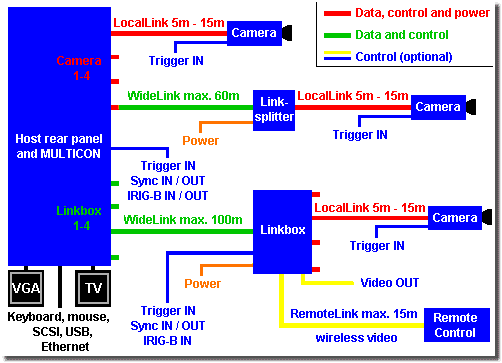
High-speed camera SpeedCam Visario g1 data and control paths
The SpeedCam Visario g1 system is a representative of the
forward-looking conception on the way to the intelligent
stand-alone camera. But still the intelligence of the system is not
located in the camera head itself. It, however, differs from the
previously described systems: the A/D conversion and memory
are integrated in the camera head. Thus according to the memory
extension up to eight Gbyte data are buffered in it. And the
according PCI bus card is called MULTICON due to its capability of
driving up to 20 cameras, four directly and four each with up to four
Linkboxes, in real time. Theses devices, especially the MULTICON,
take over the real control part inside the system.
One basic advantage of Visario is the single cable solution with
data transmission in real-time: WideLink and LocalLink cables carry
control, synchronization and trigger signals and the latter even
offer the power over wire function. Therefore the blue and yellow
control cables are just optional.
Please take notice of the propagation direction of the control
signals. There is no way back for them from the camera to the
Linkbox or the host PC. There exists a path from the host PC to the
Linkbox and further on to the camera only.
The Linkbox can substitute the host PC occasionally. The Linkbox
and its cameras can operate in stand alone mode, i.e. without
connection to the host PC. The crash-proofed Linkbox offers PAL or
NTSC live images for adjusting jobs, e.g. covering the setup in
order to prepare a crash test vehicle. Like systems with central
control unit of other manufacturers, too, this concept is
especially useful for multi-channel systems in complex and/or
widely spread test setups.
The distance between host PC and Linksplitter can be extended to
some 100 m using a fiber optic transmitter device. The Linkbox
can be remote controlled by cable or by radio. A crash-proofed
battery back-up device is available optionally as stand-alone or as
set-top box for each camera offering operation without external
power supply.
(By the way: with SpeedCam Visario the use of push-pull
connectors has gotten popular in digital high-speed camera sector
worldwide.)
One can integrate Visario in an Ethernet network and especially
using the Corba software interface it can be remote controlled.
Operating system is Windows 2000 or XP on common PCI/AGP
motherboards depending on size in a 19 inch industrial PC or as
Mini-ATX in easy portable version.
High-end camera, partly autonomous with host
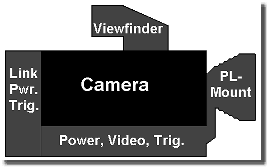
Cine SpeedCam function blocks
Optimized for the use in TV broadcast and movie business the
Cine SpeedCam system is based on the Visario architecture with a
modified and revised Visario camera core and a special sensor
selection. Of course, the image quality requirements for a camera
system used in movie and advertising business are really
extraordinary. The least feature is the completely pixel-fault free
sensor. The Cine SpeedCam marks a break-through for digital
high-speed cameras in HDTV and movie making use and was
internationally awarded in broadcast market - NAB2004, USA, Las
Vegas.
For filming work-flow the camera head offers an additional
real-time PAL or NTSC viewfinder and extended visualization,
trigger and power feed possibilities.
The Visario roots allow the use of the standard equipment
of the device family inclusive Linkbox despite its complete
different design and entire black finish.
The host in the Cine SpeedCam rack is equipped with additional
real-time high definition video cards and with fast buffer SCSI
harddisks providing a short time to render and to replay the
sequence on HDTV level.
There is also a Cine SpeedCam Mark II or »Cine g2«, a thoroughly selected, reworked and upgraded SpeedCam Visario g2 with superior image quality.
Stand-alone intelligent high-speed camcorder
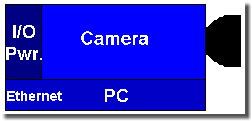
SpeedCam Visario g2 function blocks
The variation of an all-in-one self-contained high-speed camera
is marked by SpeedCam Visario g2. Here PC and control interfaces
(I/O like trigger, synchronization and IRIG-B time code) are
integrated in a crash-proofed camera head together with the further
improved Visario camera core. In simple words and with advertising
appeal expression it configures a real high-speed camcorder, even if
one will appreciate to use a notebook for camera control. Because
due to roughness reasons there is no user panel integrated. Visario
g2, however, can provide a live image at the camera directly.
The basic connection is provided by standard Gigabit Ethernet
(100/1000Base-TX) to a PC or a LAN. Its built in operating system
is Embedded Linux.
Cascading optional crash-proofed control devices (Crashunit,
Crashswitch) allow controlling and power supply of local Visario
g2 groups and of selected cameras of other manufacturers in spread
test setups. There are third party manufacturers for this kind of
power and signal hubs apart from the camera manufacturers as
well.
In easy terms a table-top power supply and a notebook with an
Internet browser are sufficient to operate the camera. A Java
camera utility for basic functions is already installed in the
camera.
Integration of a harddisk, of a flash disk, of a video output
(NTSC or PAL) or of a fiber optic interface (1000Base-FX) is
possible.
An additional integrated crash-proofed rechargeable battery
(inclusive recharging electronics) enabling complete camera
operation for up to two hours is available.
Mixed operation of different SpeedCam Visario cameras at the same control host or in the LAN is possible. Supported by a common software interface those of other manufacturers can be integrated, too. This is in respect to the set-up of extended test sites. The operating system for the host PC or the notebook is Windows 2000 or XP.
High-end stand-alone high-speed camcorder
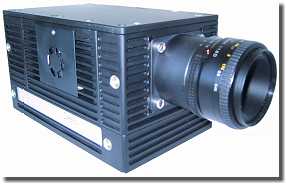
High-speed camera SpeedCam Visario g3
Functionally built up alike and even designed in a housing of
the same size the all in black finished and completely new
developed high-end high-speed camera SpeedCam Visario g3 offers a
ten times increase of the significant specs - frame rate - image
memory - sensitivity/dynamic - compared to the SpeedCam Visario g2.
The crash test ability is not killed by that. 12 bit color depth
per channel and its image quality lifts it above Cine SpeedCam
level. The edge of what is ingeniously feasible, however, is
reached - ruggedized compact design versus camcorder
functionality, see [SloMo HYCAM].
Because the interfaces are the same for Visario g2 and Visario g3
all the equipment can be used for both, even the same cables. Also
like with g2 among others internal harddisk and crash-proofed
rechargeable battery are available.
In 2010 the Fraunhofer Institut (FhG) IIS Erlangen, Germany, supplied
its camera studio with an additional multi channel system, which
can be used by third parties.
Extend [TOUR] to SpeedCam sample sequences.

